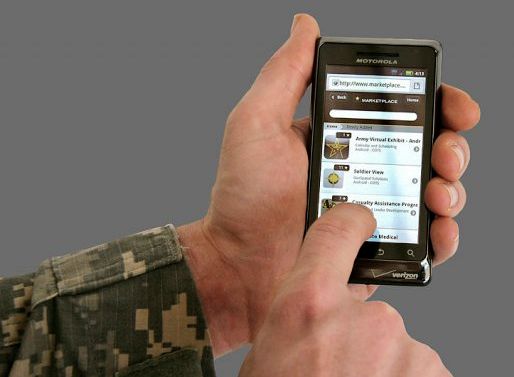Pentagon Approves iOS And Android Deployments

The Pentagon has signed up iOS and Android for duty in a move that will weaken Blackberry’s defence dominance
Mobile deployments at the US Defense Department have in the past been dominated by BlackBerry, but this will likely change as the Pentagon expands its list of supported devices.
This is because Google’s Android and Apple’s iOS mobile operating systems will now compete with BlackBerry for dominance in mobile device deployments inside the US Department of Defense as the agency moves further away from BlackBerry devices.
Opening The Ranks
In a new Commercial Mobile Device Implementation Plan announced 26 February by the Pentagon, the DoD says it will continue to push ahead with opening its ranks to new devices. The DoD dropped BlackBerry (which was then known as Research In Motion until a name change in January) as its primary mobile device supplier last October.
 The move to bring in other devices is part of the defence agency’s mobile strategy, adopted in June 2012, which calls for improving the department’s mobile devices, wireless infrastructure and mobile applications.
The move to bring in other devices is part of the defence agency’s mobile strategy, adopted in June 2012, which calls for improving the department’s mobile devices, wireless infrastructure and mobile applications.
“The Department of Defense is taking a leadership role in leveraging mobile device technology by ensuring its workforce is empowered with mobile devices,” Teri Takai, CIO for the DoD, said in a statement. “As today’s DoD personnel increasingly rely on mobile technology as a key capability enabler for joint force combat operations, the application of mobile technology into global operations, integration of secure and non-secure communications, and development of portable, cloud-enabled capability will dramatically increase the number of people able to collaborate and share information rapidly.”
The new implementation plan sets out a strategy to equip the department’s 600,000 mobile-device users with off-the-shelf mobile equipment for users of secure classified and protected unclassified mobile devices, according to the department. The DoD said it hopes to bring in the other devices and new apps to improve functionality, decrease costs and enable increased personal productivity.
“The DoD Mobile Device Strategy and Implementation Plan aim to align the various mobile devices, pilots and initiatives across the department under common objectives to ensure the warfighter benefits from these activities and aligns with efforts in the Joint Information Environment,” Takai said. “This is not simply about embracing the newest technology – it is about keeping the department’s workforce relevant in an era when information accessibility and cyber-security play a critical role in mission success.”
The DoD is not the only organisation that’s recently given up on relying solely on BlackBerry devices for its mobile users. In October 2012, the US Immigrations and Customs Enforcement agency announced that it was replacing its BlackBerry devices in a migration to Apple iPhones due to technological shortcomings.
Yahoo made a similar decision a month earlier, when new CEO Marissa Mayer announced that BlackBerry devices would no longer be provided or supported by the company as it moved to full-feature smartphones. Instead, Yahoo said it was moving its workforce over to the iPhone, Android and Windows 8 devices.
Late Comeback?
BlackBerry has been suffering from a dwindling market share after being the industry leader for enterprise-class mobile devices for years, and that shrinking market share includes verticals that had long been loyal to BlackBerry for its exceptional security features. The problem is that BlackBerry has been late responding to changing consumer and business user tastes in what they expect from their devices.
BlackBerry’s latest BlackBerry 10 devices, which add many of those smartphone capabilities while retaining the security business-friendly features of its past products, had been delayed several times in the past year, which added to the company’s market share woes.
The BlackBerry 10 line was finally unveiled in January, with the release of the products slated for April in the United States.
It’s been a rough couple of years for BlackBerry. Google’s Android was the operating system of choice on 75 percent of the 181.1 million smartphones that shipped around the world in the third quarter of 2012, which was five times the 14.9 percent market share of Apple’s iOS for the same period, according to IDC. The IDC report showed remarkable progress for the four-year-old Android OS against competition that includes the still-strong popularity of Apple iOS, a drastically smaller BlackBerry market, Microsoft’s multiple Windows Phone efforts and the rest of a straggling field.
Android was on 136 million smartphones shipped in the quarter, compared with 26.9 million smartphones shipped by Apple, according to the report. For Android, that was a 91.5 percent year-over-year jump from the 71 million Android smartphones shipped in the same quarter one year ago.
BlackBerry OS shipped on 7.7 million smartphones in the quarter, while Symbian shipped on 4.1 million units, according to IDC. Windows Phone 7 or Windows Mobile shipped on 3.6 million devices, while Linux shipped on 2.8 million units.
Android use has been going through the roof worldwide. In fact, Android hit 500 million device activations overall in mid-September, just as Apple’s latest iPhone 5 was about to launch.
The US market for feature-rich smartphones is still expanding at a rapid clip, with two-thirds of new mobile phone buyers opting for devices that can do far more than their old-style flip phones, according to a study from Nielsen last year.
What do you know about RIM and BlackBerry? Find out with our quiz!
Originally published on eWeek.